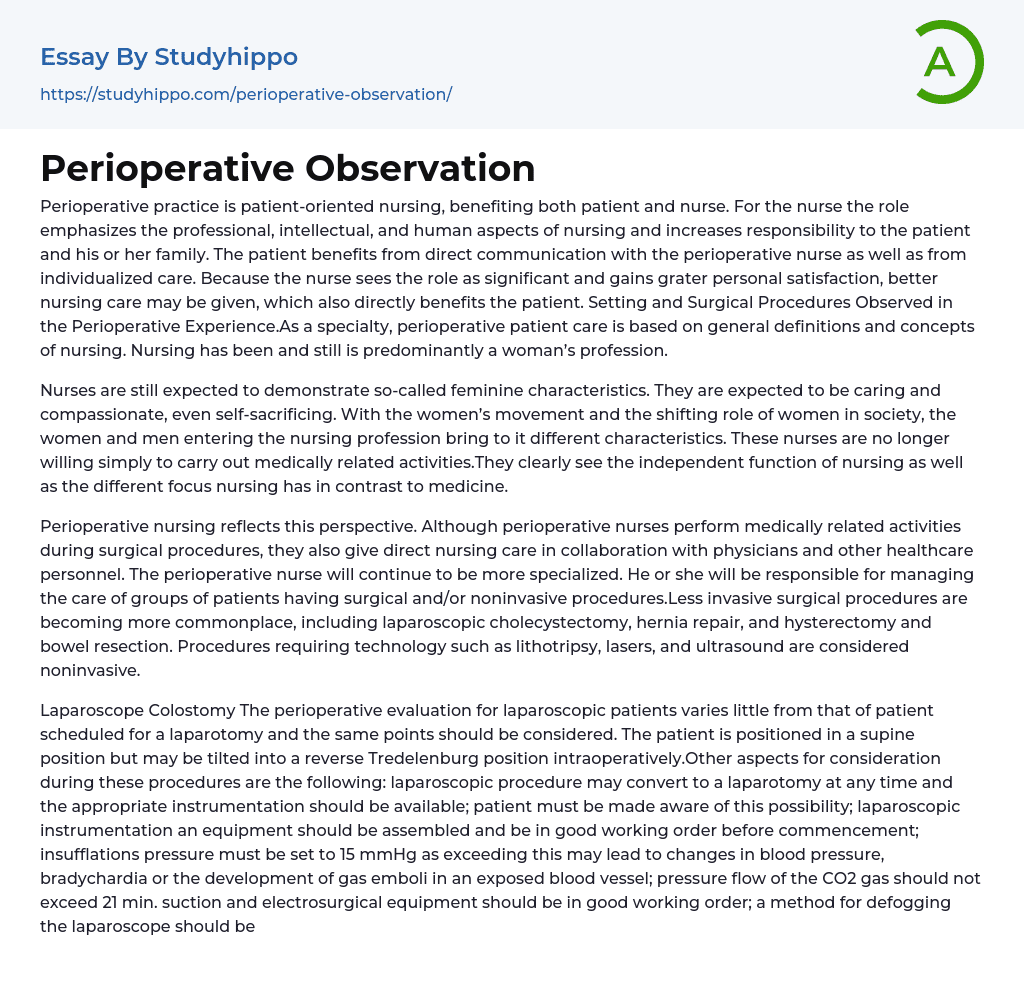Perioperative practice is patient-oriented nursing, benefiting both patient and nurse. For the nurse the role emphasizes the professional, intellectual, and human aspects of nursing and increases responsibility to the patient and his or her family. The patient benefits from direct communication with the perioperative nurse as well as from individualized care. Because the nurse sees the role as significant and gains grater personal satisfaction, better nursing care may be given, which also directly benefits the patient. Setting and Surgical Procedures Observed in the Perioperative Experience.As a specialty, perioperative patient care is based on general definitions and concepts of nursing. Nursing has been and still is predominantly a woman’s profession.
Nurses are still expected to demonstrate so-called feminine characteristics. They are expected to be caring and compassionate, even self-sacrificing. With the women’s movement and the shifting role of women in society, the women and men entering the n
...ursing profession bring to it different characteristics. These nurses are no longer willing simply to carry out medically related activities.They clearly see the independent function of nursing as well as the different focus nursing has in contrast to medicine.
Perioperative nursing reflects this perspective. Although perioperative nurses perform medically related activities during surgical procedures, they also give direct nursing care in collaboration with physicians and other healthcare personnel. The perioperative nurse will continue to be more specialized. He or she will be responsible for managing the care of groups of patients having surgical and/or noninvasive procedures.Less invasive surgical procedures are becoming more commonplace, including laparoscopic cholecystectomy, hernia repair, and hysterectomy and bowel resection. Procedures requiring technology such as lithotripsy, lasers, and ultrasound are considered noninvasive.
Laparoscope Colostomy The perioperative evaluation for laparoscopi
patients varies little from that of patient scheduled for a laparotomy and the same points should be considered. The patient is positioned in a supine position but may be tilted into a reverse Tredelenburg position intraoperatively.Other aspects for consideration during these procedures are the following: laparoscopic procedure may convert to a laparotomy at any time and the appropriate instrumentation should be available; patient must be made aware of this possibility; laparoscopic instrumentation an equipment should be assembled and be in good working order before commencement; insufflations pressure must be set to 15 mmHg as exceeding this may lead to changes in blood pressure, bradychardia or the development of gas emboli in an exposed blood vessel; pressure flow of the CO2 gas should not exceed 21 min. suction and electrosurgical equipment should be in good working order; a method for defogging the laparoscope should be available, e. g. , warm water.
Laparoscopic procedures have the benefit of shorter hospitalization, earlier ambulation, decreased post operative pain, lower wound-related morbidity, and more rapid return to normal activities. Perioperative Care: Trauma Any clotting defect which may be present is rectified and, once the patient’s condition has stabilized, she is prepared for surgery. Close observation of the patient is required throughout this period.If at all possible, it is helpful to allow close relatives to see the patient before surgery as this may relieve a little of both their patient’s anxiety. Post operative care is as for abdominal surgery requiring general anesthesia and the patient will usually be nursed in a high-dependency area.
Perioperative Care: Hypersplenism In preparation for elective splenectomy, a full assessment of the patient’s blood count and coagulation status must
be made. In the presence of any bleeding tendency, a transfusion of blood or platelets may be administered.In patients with thrombocytopenia, platelets should be made available for use to cover the intra- and post operative phase. An anti-pneumococcal vaccine is given to prevent or minimize chest infection postoperatively.
Influenza Type B vaccine is also given prophylactically. Preparation for surgery is as for abdominal surgery requiring general anesthesia. A nasogastric tube is passed because of handling of the stomach during surgery and the subsequent risk of aspiration of stomach contents.In the postoperative period, the physiotherapist plays an important role in the care of these patients because of the increased risk of collapse of the left lower lobe of the lung.
The nurse must encourage the patient to perform deep breathing exercises and aid expectoration between physiotherapy sessions. Some doctors advise the administration of low-dose heparin in all patients undergoing splenectomy as there will be a transient increase in platelet and leukocyte levels.The nurse must therefore be aware of the importance of passive exercises while the patient is on bed rest and encourage movement and early ambulation. Another complication which can follow splenectomy is pancreatitis caused by the handling and bruising of the tail of the pancreas during surgery. Therefore the nurse must be alert to any change in the patient’s condition, especially any increase or change in the nature of the pain experienced.
- Psychometrics essays
- Measure essays
- Why I Want to Be a Nurse essays
- Nursing Profession essays
- Why Did You Choose Nursing essays
- Adaptation essays
- Adventure essays
- Adversity essays
- Aging essays
- Alcohol essays
- Barbie Doll essays
- Beauty essays
- Care essays
- Carpe diem essays
- Change essays
- Chess essays
- Chicken essays
- Choices essays
- Contrast essays
- Crops essays
- Development essays
- Dream essays
- Evil essays
- Experience essays
- Family essays
- Farm essays
- Fire essays
- First Love essays
- Focus essays
- Greed essays
- Hero essays
- Holiday essays
- House essays
- Housing essays
- Humility essays
- Humor essays
- Hypocrisy essays
- Integrity essays
- Law of Life essays
- Life Changing Experience essays
- Life Experience essays
- Lifestyle essays
- Limitations essays
- Love Story essays
- Mother Tongue essays
- Motherhood essays
- My Neighborhood essays
- Myself essays
- Mystery essays
- Narcissism essays




